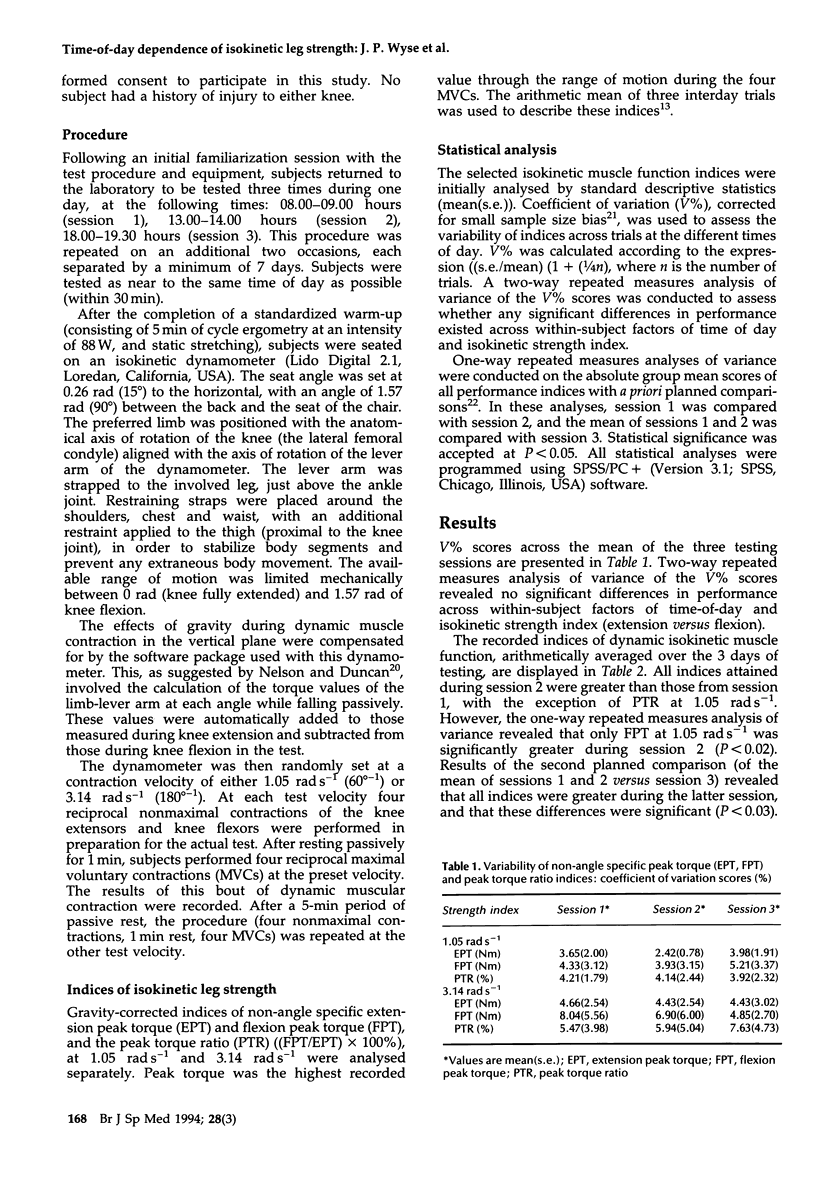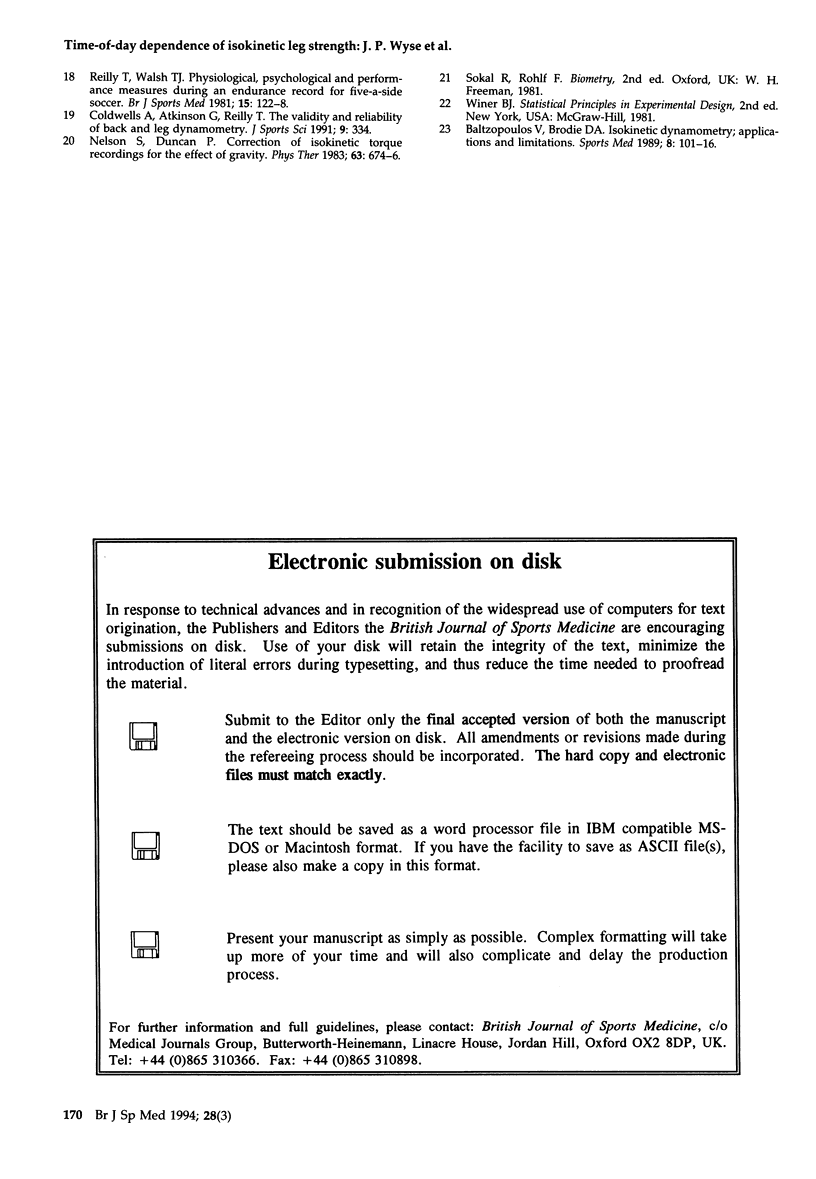Abstract
The purpose of this study was to assess the interday variability and time-of-day effects on selected isokinetic leg strength indices. Nine adult collegiate sportsmen (mean(s.e.) age 19.6(0.5) years; mean(s.e.) height 1.81(0.02) m; mean(s.e.) body mass 76.5(3.1) kg) completed a series of nine test sessions, organized so that each subject was tested three times within a day (08.00-09.00 hours; 13.00-14.00 hours; 18.00-19.30 hours), on three occasions, each separated by a minimum of 7 days. Gravity-corrected indices of extension peak torque (EPT), flexion peak torque (FPT), and the peak torque ratio (PTR), at contraction velocities of 1.05 rad s-1 and 3.14 rad s-1, were calculated for each subject using an isokinetic dynamometer. Two-way repeated measures analysis of variance of coefficient of variation (V%) scores revealed no significant differences in performance variability across within-subject factors of time-of-day and performance index (P > 0.05). Overall mean(s.e.) V% for scores across experimental conditions were 3.97(0.72)% at 1.05 rad s-1 and 5.98(1.23)% at 3.14 rad s-1, suggesting that similar levels of measurement error occur between 08.00-19.30 hours. One-way repeated measures analysis of variance of absolute strength indices (EPT, FPT and PTR) revealed that significantly higher scores were achieved during session 3 (18.00-19.30 hours), with mean(s.e.) values of 249.1(40.0) N m, 149.0(32.3) N m, 59.5(5.0)% at 1.05 rad s-1, and 172.1(38.7) N m, 121.3(27.7) N m, 71.1(6.2)% at 3.14 rad s-1, respectively (P < 0.05). This finding appears to be consistent with current knowledge about time-of-day effects on the assessment of muscular strength. Thus for stable and maximal values to be obtained during isokinetic leg testing, the use of multiple-trial protocols is recommended, with testing occurring as close to 18.00-19.30 hours as possible. In addition, the observed significant time-of-day effect suggests that appropriate comparison of maximal isokinetic leg strength can only be achieved based on data obtained within 30 min of the same time of day.
Full text
PDF



Selected References
These references are in PubMed. This may not be the complete list of references from this article.
- Baltzopoulos V., Brodie D. A. Isokinetic dynamometry. Applications and limitations. Sports Med. 1989 Aug;8(2):101–116. doi: 10.2165/00007256-198908020-00003. [DOI] [PubMed] [Google Scholar]
- Baxter C., Reilly T. Influence of time of day on all-out swimming. Br J Sports Med. 1983 Jun;17(2):122–127. doi: 10.1136/bjsm.17.2.122. [DOI] [PMC free article] [PubMed] [Google Scholar]
- Burnie J., Brodie D. A. Isokinetic measurement in preadolescent males. Int J Sports Med. 1986 Aug;7(4):205–209. doi: 10.1055/s-2008-1025759. [DOI] [PubMed] [Google Scholar]
- Gleeson N. P., Mercer T. H. Reproducibility of isokinetic leg strength and endurance characteristics of adult men and women. Eur J Appl Physiol Occup Physiol. 1992;65(3):221–228. doi: 10.1007/BF00705085. [DOI] [PubMed] [Google Scholar]
- Johnson J., Siegel D. Reliability of an isokinetic movement of the knee extensors. Res Q. 1978 Mar;49(1):88–90. [PubMed] [Google Scholar]
- Kannus P. Relationship between peak torque and total work in an isokinetic contraction of the medial collateral ligament insufficient knee. Int J Sports Med. 1988 Aug;9(4):294–296. doi: 10.1055/s-2007-1025025. [DOI] [PubMed] [Google Scholar]
- Nelson S. G., Duncan P. W. Correction of isokinetic and isometric torque recordings for the effects of gravity. A clinical report. Phys Ther. 1983 May;63(5):674–676. doi: 10.1093/ptj/63.5.674. [DOI] [PubMed] [Google Scholar]
- Oberg B., Ekstrand J., Möller M., Gillquist J. Muscle strength and flexibility in different positions of soccer players. Int J Sports Med. 1984 Aug;5(4):213–216. doi: 10.1055/s-2008-1025908. [DOI] [PubMed] [Google Scholar]
- Read M. T., Bellamy M. J. Comparison of hamstring/quadriceps isokinetic strength ratios and power in tennis, squash and track athletes. Br J Sports Med. 1990 Sep;24(3):178–182. doi: 10.1136/bjsm.24.3.178. [DOI] [PMC free article] [PubMed] [Google Scholar]
- Reilly T., Walsh T. J. Physiological, psychological and performance measures during an endurance record for 5-a-side soccer play. Br J Sports Med. 1981 Jun;15(2):122–128. doi: 10.1136/bjsm.15.2.122. [DOI] [PMC free article] [PubMed] [Google Scholar]
- Rochcongar P., Morvan R., Jan J., Dassonville J., Beillot J. Isokinetic investigation of knee extensors and knee flexors in young French soccer players. Int J Sports Med. 1988 Dec;9(6):448–450. doi: 10.1055/s-2007-1025049. [DOI] [PubMed] [Google Scholar]
- Thorstensson A., Grimby G., Karlsson J. Force-velocity relations and fiber composition in human knee extensor muscles. J Appl Physiol. 1976 Jan;40(1):12–16. doi: 10.1152/jappl.1976.40.1.12. [DOI] [PubMed] [Google Scholar]
- Winget C. M., DeRoshia C. W., Holley D. C. Circadian rhythms and athletic performance. Med Sci Sports Exerc. 1985 Oct;17(5):498–516. [PubMed] [Google Scholar]


